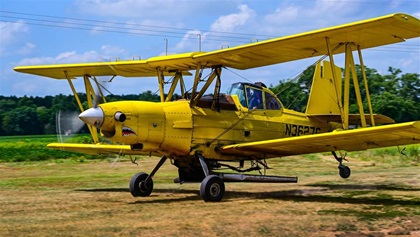Ag pilot
Stick and rudder, and lots of science

Ag pilots now fly turboprops almost exclusively, and the flow from the liquid chemicals they disperse is computer-controlled to match satellite images showing where more or less is needed.
Instead of following signals from a “flag man” standing at the edge of each field, ag pilots follow precise GPS grids with each pass—resembling an IFR pilot flying a localizer approach. The GPS provides lateral guidance, and the pilot is in charge of terrain and obstacle separation.
“The flying is so precise that it’s got to be almost second nature,” said Graham Lavender, publisher of Ag Air Update, a trade magazine for the agricultural flying industry. “Being successful in ag flying requires a special set of skills, and flying the airplane is only a part of it.”
Ag pilots must be well versed in farming, understand their customers and the demanding nature of their work, and know how to properly mix and safely disperse chemicals. Each state has its own license for chemical applicators, which includes ag pilots. Most ag pilots start as ground workers under the guidance of a mentor to learn the trade before they begin flying.
From the FAA perspective, ag pilots must be commercial pilots and hold second class medicals. A tailwheel endorsement is handy, too, since virtually all ag aircraft fit that description.
There are about 4,000 ag pilots in the United States, and those at the top of their game earn between $200,000 and $250,000 annually.
Most are based in one location, and a relative few are “nomads” who follow the seasons—north in summer, and south in spring and fall.
The average ag pilot age is 55 years old, so it’s likely the next decade will bring a surge of retirements that won’t be easily filled.
Ag flying also can be cruelly unforgiving. An average of 10 pilots die in ag flying accidents each season, and collisions with obstacles is a common cause.
There are fewer ag pilots now than decades ago, and the main reason is that their aircraft are so much more capable. Instead of piston airplanes with 40-foot wingspans carrying 100 gallons and crossing fields at 85 knots, they fly turboprops with 65-foot spans carrying up to 800 gallons and crossing fields at 140 knots. Even so, however, there’s a pilot shortage.
“There were more acres in need of (chemical) treatment last year than airplanes or pilots,” Lavender said. “And the demographics suggest that’s likely to continue.” FT

 Qualifications: Commercial certificate; State chemical applicator’s license; tailwheel endorsement and turboprop experience highly desirable.
Qualifications: Commercial certificate; State chemical applicator’s license; tailwheel endorsement and turboprop experience highly desirable.

